







Bethlehem Crossing
May 11, 2006 - Post No. 76

After sunset, from the Armenian Convent rooftop,
Bethlehem.
The experience of Bethlehem on my two previous trips was not entirely positive. The last time I visited Bethlehem, almost two years ago to the day, we were a small group on a side trip from the Deans' Conference at St. George's College, Jerusalem. The Israelis were doing everything they could to discourage the flow of tourist dollars to Bethlehem, an economic embargo of sorts, and our bus was not allowed through the check point. We had to cross on foot and then fell prey to a horde of desperate, truly desperate Bethlehem Palestinians who hoped to extract every tourist dollar they could from our small group of North Americans. This meant getting us into their taxi or car so that they could organise the details of our visit: tour guide, lunch and shopping -- making sure that every penny fell into the palms of a member of the extended family. At times we felt entirely commandeered, and it was not a pleasant experience -- though not as dangerous as it might sound.

My first instinct on this trip was to stay clear of Bethlehem entirely; but the report from C-B and Evelyn Baker suggested that things really had improved in Bethlehem. There are a lot more tourists and pilgrims in the Holy Lands this year, and the Israelis are not obstructing access to Bethlehem. Well, as these photos suggest, the road is certainly blocked, but the blocking has more to do with keeping the people of Bethlehem in, rather than tourists and their wallets out.

Bethlehem, without the obstacle of the wall and its check point, is barely 10 minutes from the door of the Armenian Convent (the monastery) in Old Jerusalem. Thanks to the ever capable Sarkis my driver, (cf. "Tour of Galilee") all goes well. He makes this trip three or four times a week and has a diplomatic identity card (and the Patriarch's van has diplomatic plates, to match). Sarko banters easily with the Israeli soldiers, "It's a nice day, why aren't you at the beach in Tel Aviv?" ... and we are quickly waved through the imposing checkpoint.
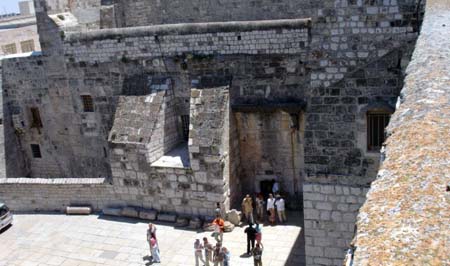
The Armenian compound in Bethlehem is part of the larger ecumenical complex of the great Church of the Nativity. The organisation of the complex reflects the status quo configuration with three communities based here: the Franciscans, the Greeks, and the Armenians. This photo, above, is taken from the rooftop of the Armenian Convent -- as is the first photo in this report, taken after sunset in the direction of Manger Square. In this photo, above, we see the famous entranceway to the Byzantine Church of the Nativity. The doorway is less than five feet high, though once a much grander entranceway. It was lowered to prevent Ottoman horsemen from charging into the basilica.
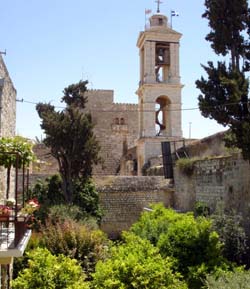
The Armenian Convent is reached through the Narthex (entrance way) of the basilica, through another short doorway that opens onto a walled garden, and a flight of stairs leading up to the convent living quarters. This picture (right) is taken from the convent looking towards the Greek monastery with its bell tower, on the other side of the wall.
Several joined buildings make up the living quarters of the Armenian convent: a kitching-dining hall, a formal reception hall, a large chapel, and private apartments in a U-shaped residence. This is home to Fr. Khat, the director of the convent; the married priest, Fr. Vachagan his wife Ireni, their newborn son, Nareg (father and son are pictured here); and two deacons.

Baby Nareg will be 2 months old on May 15th, and this photo is taken in the courtyard just outside the convent's dining hall. It seems more than appropriate to find an infant in arms only a few steps away from the birthplace of Jesus.
The buildings that make up the living quarters of the Armenian Convent are built on top of a medieval hostel that once welcomed Armenian pilgrims who would travel here, for the most part on foot, from Armenia. Pictured below, the former refectory (dining hall) of the hostel.

Up until now, I've been using the term "monastery" to talk about what the Armenians seem generally to call a "convent." There are no nuns here, nor are there any in Jerusalem, but they call the compound itself (in both places) a convent, and both are inhabited by monks and the laity alike.
The roof of the Armenian Convent is quite large, flat, and covered with stone tiles. Groups often climb the stone stairway to the roof, to take in the wonderful views it offers of Bethlehem and the surrounding region. This photo was taking from the rooftop looking towards the hills to the south of Bethlehem.
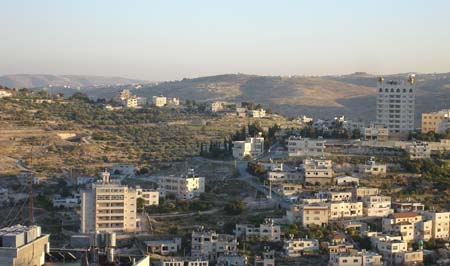
On my arrival, after the usual formalities of coffee, treats and tea (in that order), I am taken to my room which is quite nice, with en suite bathroom, opening onto the courtyard of the convent residence.
Later, I take some time to explore the town of Bethlehem, and I soon realise that I am something of a novelty in that most visitors arrive in buses, have a quick visit to the basilica and the Nativity Grotto -- the traditional birthplace of Jesus -- and then climb aboard back their buses for the return trip to Jerusalem. Very few actually wander around the town ... which means that tourist dollars are not exactly flowing in Bethlehem as yet. As I wander further from the Church of the Nativity, I am approached less often by tourist shop owners, taxi drivers, postcard sellers, and tourist guides. It is the end of the market day, and the last day before the Moslem holy day, Friday.
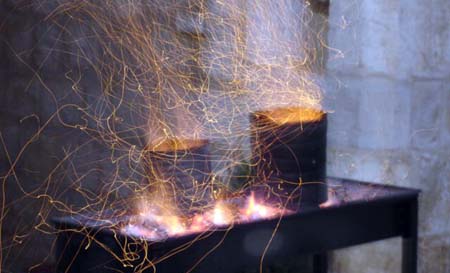
Returning to the convent, I discover preparations underway for a
"kebab" -- a typical Middle Eastern banquet that Fr. Khat is throwing in
honour of a young Armenian couple from Dubai who have returned to
Bethlehem to visit their family here. The young husband works as a
flight attendant for Emirates airlines, and tells me that once the new
airbuses are online (expected in 2007, now), Emirates will be offering
flights to Montreal, Toronto and Vancouver -- meaning travel to
 Australia,
Arabia and Southern India will become much more affordable.
Australia,
Arabia and Southern India will become much more affordable.
Fr. Khat (pronounced with the strong guttural throat clearing of the Armenian "kh") is a most gracious host. An engaging personality, he entertains the assembly with wonderful stories. He is a native of Beirut -- not Bouj Hammoud (the Armenian enclave their) but a neighbouring quarter -- and knows most of the monks at the Catholicosate in Antelias. He speaks fluent Arabic, as much his first language as is Armenian, which serves him well with the small Armenian population of Bethlehem (75 families) which is primarily Arabic speaking.
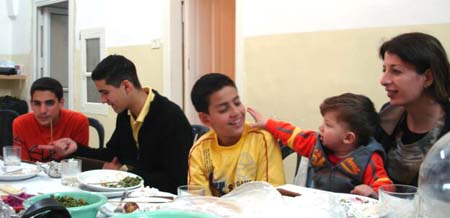
The kebab is very much a family affair, the residents of the Armenian
Convent and the members of the visiting couple's extended family (the
visiting mother and infant son, pictured above) are joined by other
friends of Fr. Khat's from the local Christian community -- perhaps 20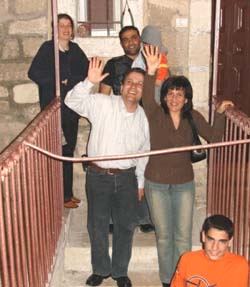 guests in all for a wonderful round of mezze and kebab.
guests in all for a wonderful round of mezze and kebab.
The Palestinians (Armenian and Arab) are extremely friendly, and I am soon made to feel very much at home and among new friends. It seems apparent that I could have a fairly full social calendar were I to stay on in Bethlehem for a few days -- everyone asks how long I am staying and when I can come to their home for a meal. The party breaks up around midnight, and spirits are high at our parting.
The principle mission of the Armenian clergy here, two priests and two deacons, is centred on the daily round of liturgical celebrations at the Church of the Nativity. The expression "use it or lose it" could easily serve as the operating principle for life in the status quo economy of the Christian Holy Lands. The Armenians have rights to maintain a chapel (pictured below) set in an alcove of the basilica next to the Byzantine sanctuary and chancel; and to celebrate the morning and evening offices there. They also have the historic right to celebrate a daily Badarak in the Nativity Grotto below, reached by an small amphitheatre of steps to the right of the altar pictured here. If the Armenians were to scale back operations here, with fewer offices and liturgies, then their rights would be scaled back as well. "Use it or lose it."
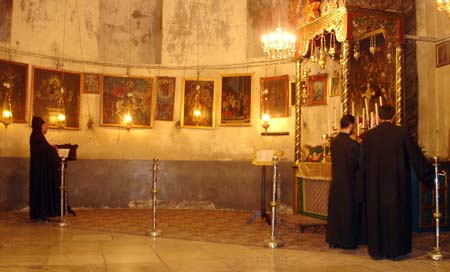
The time slot for the Armenian morning prayers is from 5 to 5:45 a.m. every morning. It's easy enough to wake for the early offices, the local Moslem call to prayer, blasted from a dozen loud speakers at top the minaret of the main mosque in Manger Square -- one of hundreds of local mosques -- has me "on my toes" at 4 a.m.! It is a quiet hour in the basilica of the Nativity, and I am thankful for this exceptional experience of daily life here ... and for more than a few moments to sit in mediation before the star marking the spot where Jesus was born, in the Grotto cavern below the Greek sanctuary.
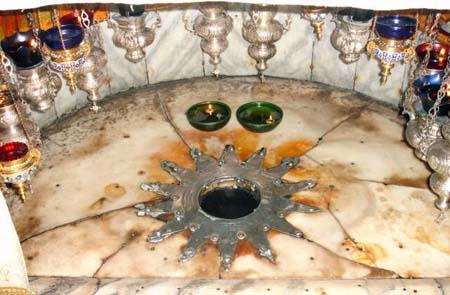
Following morning prayer, I return to bed for about an hour, and then rise to enjoy a brisk morning walk through the town of Bethlehem. Here is Manger Square, looking away from the basilica, toward the mosque and souq (the market district) of Bethlehem.
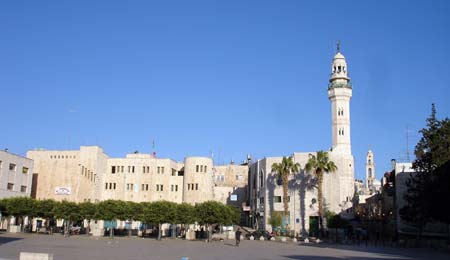
It is Friday morning, the Moslem holy day, and the town is very quiet. The warmth of the day -- Bethlehem is set on the edge of the Judean wilderness and desert -- is already in the air. There will be no rain now until December, at the earliest, and I carry the obligatory bottle of water to prevent dehydration in this very dry climate.

The international community has been busy in recent years, investing in a variety of humanitarian and patrimonial projects in Bethlehem. Much of this activity was connected up to the millennium celebrations here in 2000 -- the the happy days before the second Intifada.

The Spanish government has been restoring the medieval Armenian pilgrims' hostel and there is still a lot left to do. Several countries have projects here, many offering new social options for the local population like the community centre pictured above, and several new schools, health clinics, a mother and child centre and other facilities that I see along the way on my early morning walk, and on other trips through the area.

Sunrise on the town of Bethlehem is beautiful, and this photo is taken looking across to Manger Square from a hill across the way -- note the bell tower of the Greek monastery, left, and the minaret of the main mosque, right.
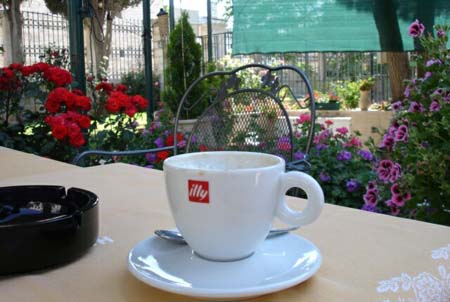
Across from the entrance area of the basilica and the Armenian monastery, the Franciscans have a large guest house and hotel with a lovely garden bistro offering the pleasant prospect of a tasty cup of cappuccino at the end of my morning walk ... There is also a copy of the Jerusalem Post, only a couple of days old, and the chance to catch up with some of the news of the region.
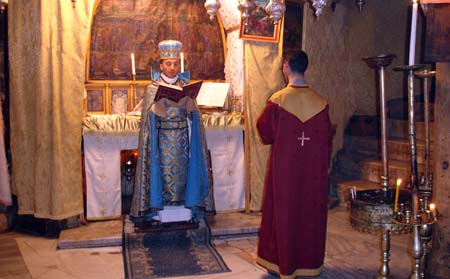
Then, returning to the monastery I join the Armenian convent's liturgical guard for the daily Badarak in the Grotto cavern. The star marking the birth spot of Jesus is underneath the altar in this photo here.
Click here for a recording of the singing during the Grotto Badarak. This was recorded the following morning, my last in Bethlehem, Fr. Khat is the celebrant, heard also the singing of the deacons, and Fr. Vachagan is "the choir" ... He has a strong voice, and the recording features the hymn of peace, from this troubled city of peace, Bethlehem.
Christ in our midst has been revealed;
Who is God is here seated.
The voice of peace has resounded;
Holy greeting has been shared.
The Church is made as one person
This kiss given as the bond of fullness.All enmity has been removed;
And love is spread over us all.
(cf. Easter Magnificence & Anglican Evensong for other renditions of this hymn.)